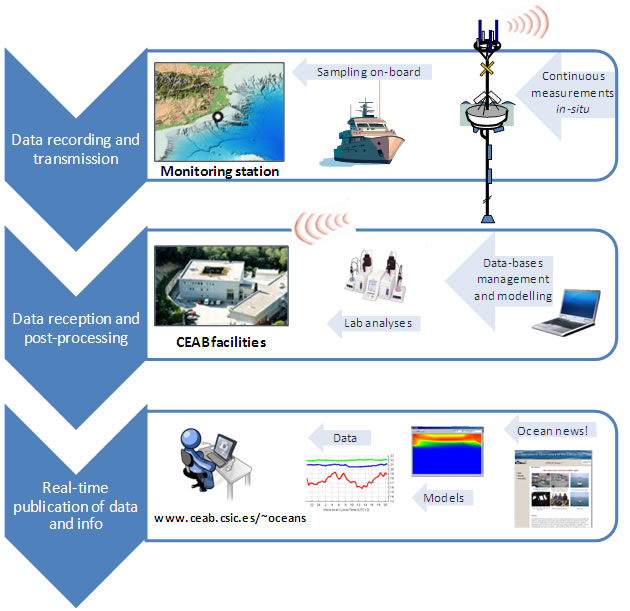
|
||
Presentation
|
Definition The Operational Observatory of the Catalan Sea (OOCS) consists of several components from observations to modeling of the NW Mediterranean Sea (see Figure). Multiparametric Oceanographic BuoyThe oceanographic buoy is the most visible component of the Observatory. The buoy system is composed by a doughnut-type float with an emerging structure containing a full set of meteorological sensors, the central data-logging facility and the real-time communications system. In addition, the buoy has underwater instruments measuring, at various depths, a number of oceanographic and ecological magnitudes. More details are provided in the buoy description section. Complementary Sampling and Infrastructure Maintenance Fortnightly CTD and Niskin bottle casts started in March 2009 on board the CEAB’s vessel DOLORES. To perform the cast, a SeaBird 19+CTD equipped with fluorescence, PAR and turbidity sensors is used. Bottle samples are used in lab to measure spectrophotometric chlorophyll-a concentration, dissolved oxygen using the Winkler method, and nitrate, nitrite, phosphate and silicate concentrations. Six-monthly visits on board R/V GARCIA DEL CID are performed at the mooring site. On-deck inspection and maintenance of the instrumentation on the buoy is carried out. A grid of CTD stations covering the continental shelf and the slope around the mooring site is performed at each cruise in order to study local space variability of the environmental conditions. Real-time Modelling and Forecast Real-time modelling and forecast is expected to be performed using the models developed by Group members: 1DV model [Bahamon & Cruzado, 2003] for the mooring site, a 3D hydrodynamic model for the Catalan Sea [Ahumada & Cruzado, 2007] and 3Dcoupled hydrodynamic-biogeochemical [Bernardello et al,. submitted] for Western Mediterranean Sea. The models are being adjusted to assimilate data obtained from the OOCS observing system as well as from remote sensing. Forcings from the European Centre for Medium-Range Weather Forecasts (ECMWF) are being used to perform marine hincasts and will be used to produce real time operational forecasts. 7-days forecast of the biogeochemical and oceanographic conditions are expected to become available shortly and made available to public at a dedicated webpage. Historical Data Oceanographic cruises carried out by the team in the last four decades in the study area providing historical information of hydrographic and biogeochemical conditions in the area will be accessible on-line. Relevant features dealing with colleted historical data can be found in several doctoral theses [i.e. Velásquez, 2002; Grimaldo, 2004; Segura, 2008]. Data are under quality control processing at US NOAA Ocean Climate Laboratory. Quality Control Development and implementation of a Quality Control Program for all the components of the Observatory is in progress. Data are published once passed a first level quality control. Instrumentation room At CEAB facilities, a room is available for doing electronic and oceanographic instrumentation maintenance tasks. |
|||

